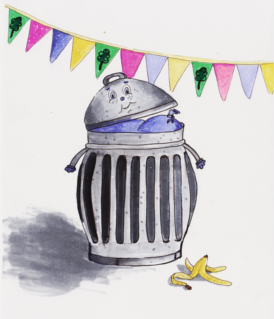Solid household waste
In developed countries, the amount of plastic and paper used is constantly increasing, and the rhythm of life it leads to the fact that it is cheaper to throw away a thing than to fix it, so it increases every day the amount of garbage thrown out in cities and settlements.
Types of household waste
The main types of solid household waste are presented below:
- Organic waste - leftovers from food and cooking, for example, animal bones or eggshells
- Paper and cardboard - newspapers, magazines, boxes, packaging material, etc.
- Plastic - bottles, bags, boxes, dishes, etc.
- Glass - bottles, broken dishes and others
- Metal - cans, bottles, etc.
Additionally allocate:
- Batteries
- Electronics
- Tetra Pak
In developed countries, the predominant amount of paper and plastic, in developing countries - organic waste.
Waste collection points in Russia are collected on the map https://recyclemap.ru /
Amount of household waste

On average, the amount of household waste per person per year in Russia is 445 kg / person, in the USA 760 kg / person, in Italy and Spain - 550 kg / person. The amount of waste depends on the time of the year and the day of the week. Also, the amount of garbage increases on holidays and weekends, sports holidays and so on. In summer, the amount of organic waste increases, whereas in winter the amount of ash and ash increases.
The life cycle of household waste
It includes the following stages: household waste is collected, transported and processed.
Collection of household waste
There are two types of solid waste collection: general and separate garbage collection. General garbage collection implies a container into which all garbage is dumped for further transportation. Separate garbage collection implies a separate container of a certain color for each type of garbage:
- Green - Glass (bottles, glasses)
- Blue - Newspapers, magazines and other printed publications
- Yellow - Cardboard, empty cardboard packages
- Black - Organic residues, food waste (for example: compost)
- Brown - Hazardous waste (batteries)
- Red - Non-recyclable waste
- Orange - Plastic bottles and plastic packaging
Solid waste transportation
At the moment there are two methods of garbage transportation: collection by garbage trucks and using pneumatic waste transportation systems. The first method is used much more often, there are two main types garbage trucks - some simply transport garbage, others press it directly during collection. The pneumatic transportation system is located underground and transports waste through the pipe system by means of compressed air.
Garbage is transported to the places of processing, as a rule it is either a sorting point or a landfill.
Solid waste treatment
The worst option is to send the garbage to the landfill, as an uncontrolled landfill - it is a source of pollution, diseases and many other problems related to the lives of people and animals, as well as the entire planet as a whole. The problem at the moment is that the existing methods in general, they are economically unprofitable and rather engineers are busy trying to extract at least some benefit from garbage processing, rather than finding a way to make money on it.
At the moment, garbage is processed in one of the following ways:
- Recycling - garbage is recycled for use as secondary raw materials, for example, an aluminum can can become a laptop case
- Incineration - incineration of garbage to produce heat and reduce the mass and volume of waste
- Landfill - disposal of waste in abandoned mines and pits
- Burial - disposal of waste in specially created and controlled landfills
- Compost - processing of biological waste to produce biofuels - fertilizers and methane gas

